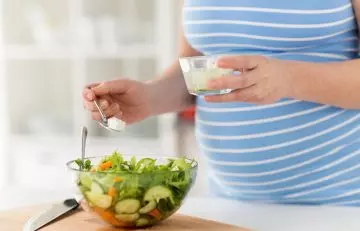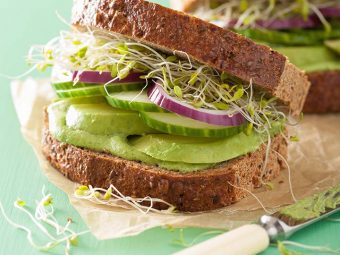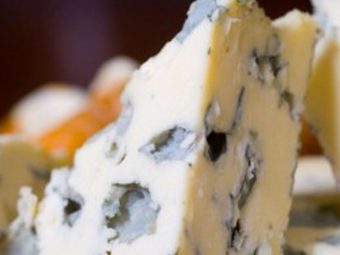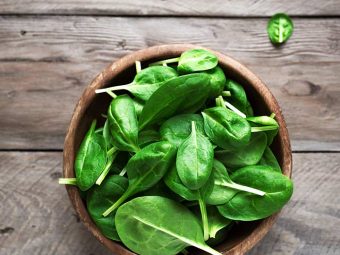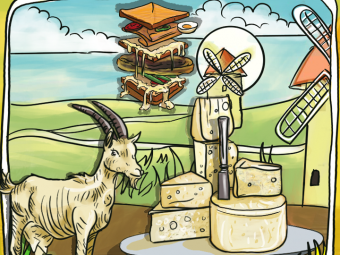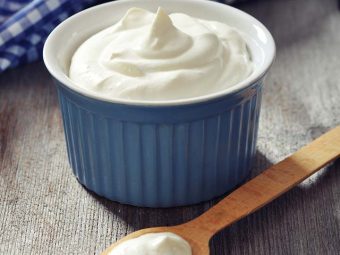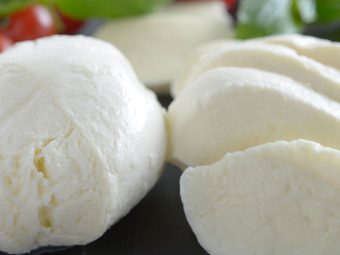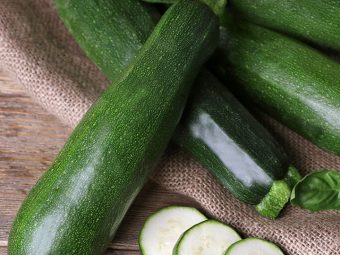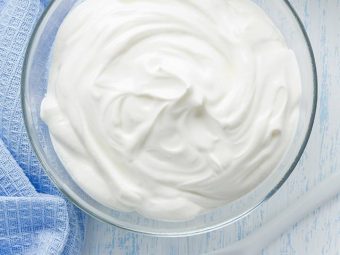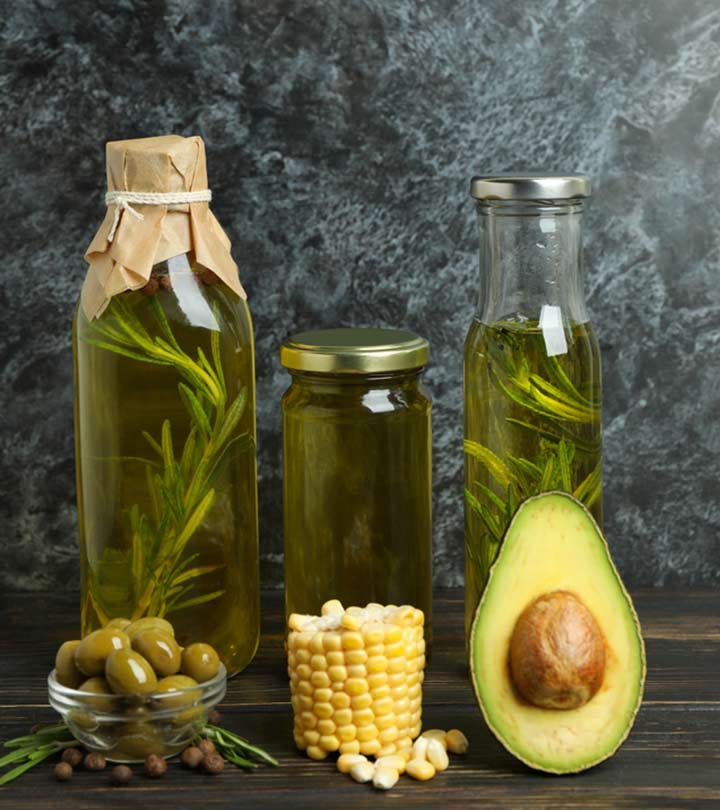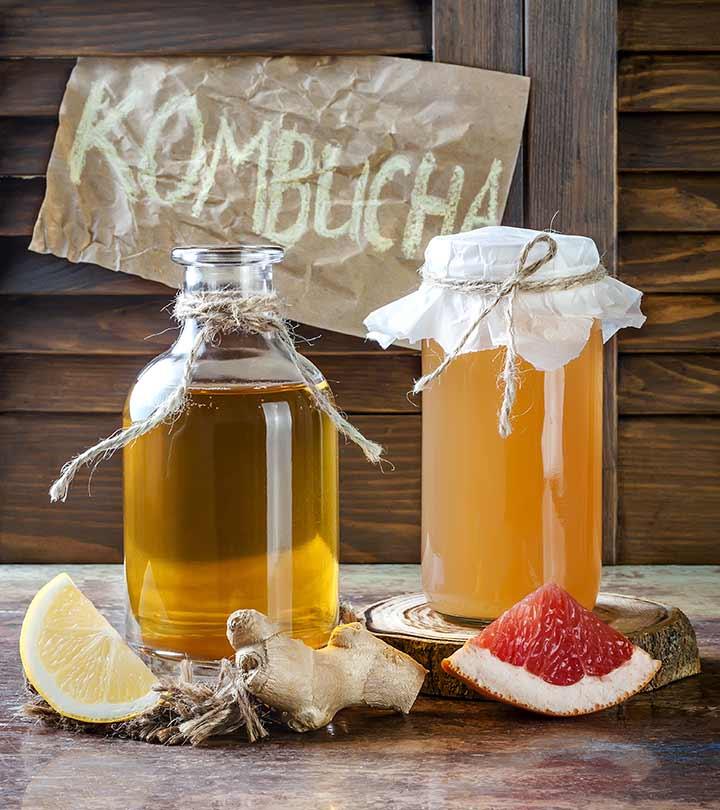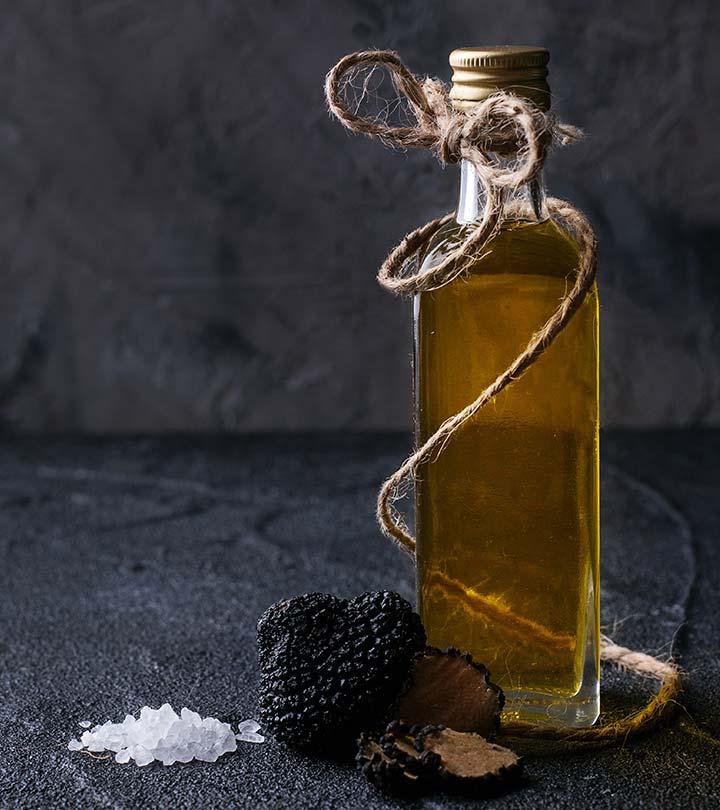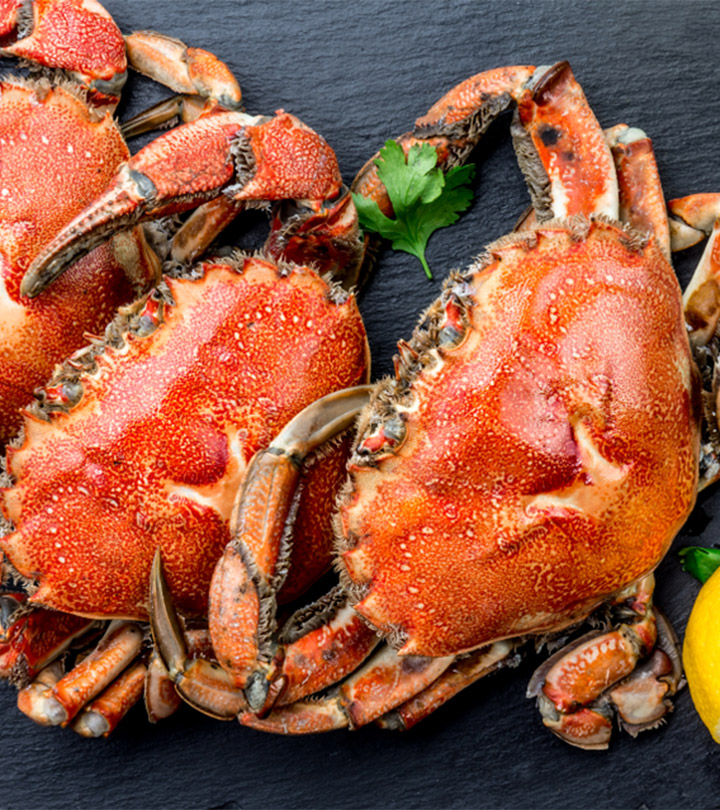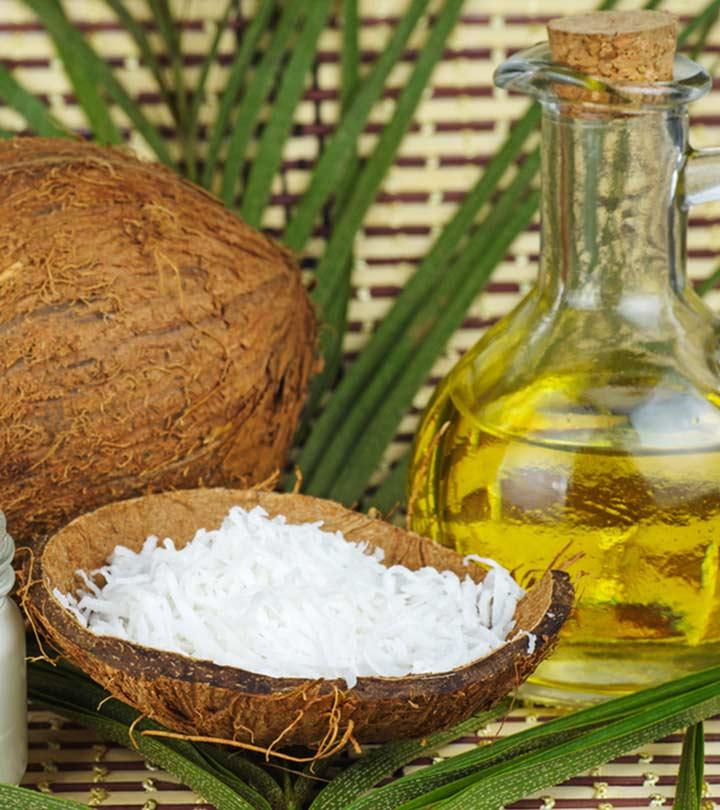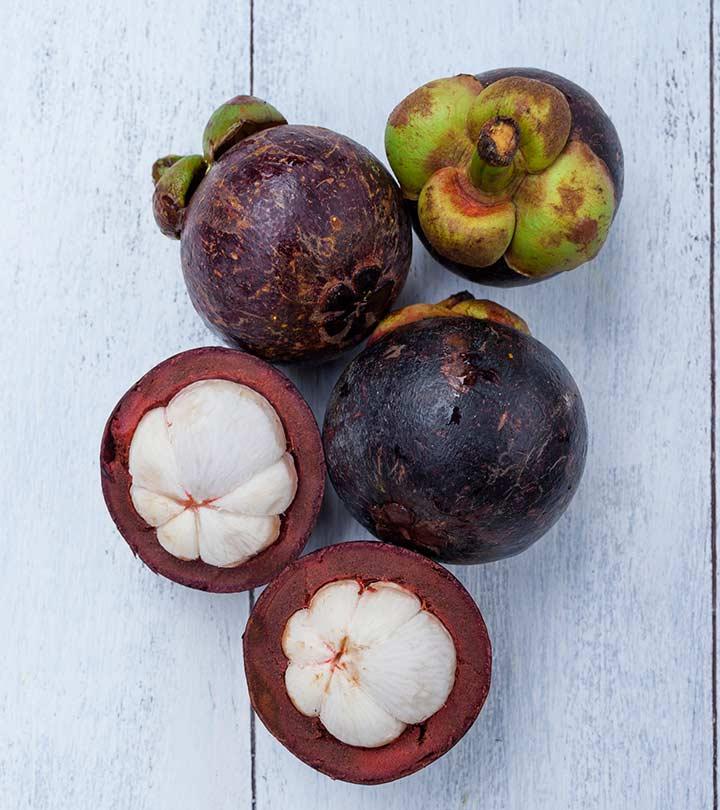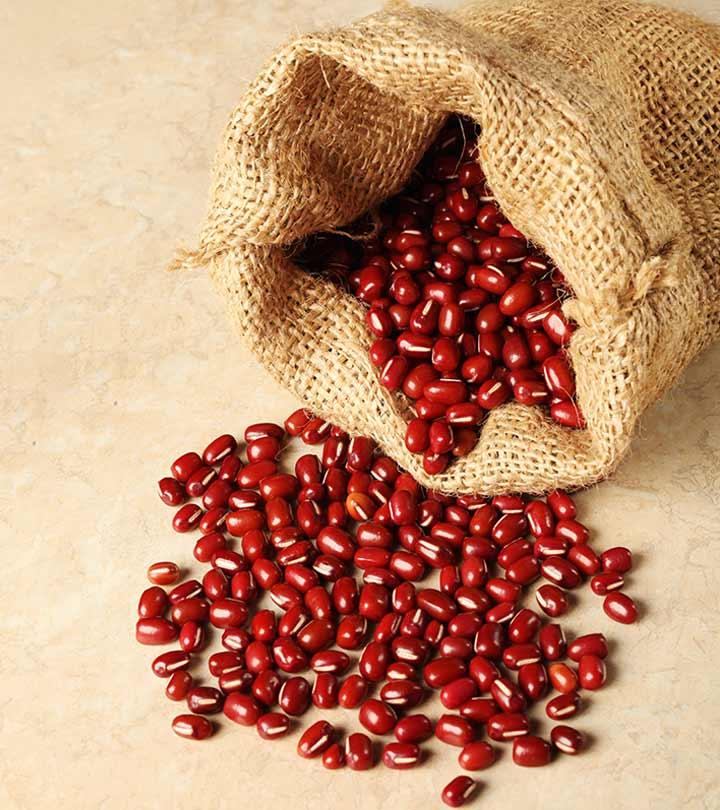11 Health Benefits Of Cheese, Different Types, Tips, & Recipes
From promoting bone health to reducing cancer risks, cheese can benefit you in surprising ways.
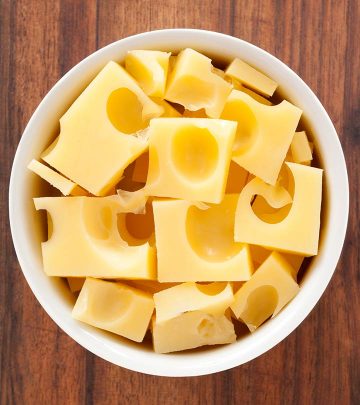
Image: istock
Cheese benefits are not limited to its delightful creamy texture. This nutrient-dense food is packed with calcium and protein and has an impressive nutrient profile.
The benefits of cheese include promoting bone and dental health, reducing blood pressure, promoting weight gain, and possibly even protecting against cancer.
This article discusses the benefits of cheese, its nutritional profile, how to use it for maximum benefits, and any potential side effects. Keep reading.
 Know Your Ingredient: Cheese
Know Your Ingredient: CheeseWhat Is It?
A semisolid dairy product formed as a result of curdling milk.
What Are Its Benefits?
Cheese promotes bone health, reduces high blood pressure, imparts glow to the skin, and reduces blemishes.
Who Can Consume It?
Everyone can consume it, except for people who are lactose intolerant and allergic to milk proteins.
How Often?
Around 40 gms of cheese every day is safe for consumption.
Caution
Individuals with weight issues and cardiovascular diseases should consume low-fat and low-sodium cheese.
In This Article
Nutrition Facts
Cheese contains many vitamins and minerals. According to the United States Department of Agriculture, (USDA) 100g of cheese contains (1):
- Energy – 362 kcal
- Protein – 5.17 g
- Carbohydrate – 50 g
- Calcium – 69 mg
- Sodium – 181 mg
- Saturated Fatty acids – 3.45 g
- Cholesterol – 34 mg
It is a rich source of protein, vitamin A, vitamin K, and calcium. It can offer a variety of health benefits, which we will explore in the following section.
Health Benefits Of Cheese
1. May Promote Bone Health
Cheese is a rich source of calcium, magnesium, vitamins, and protein (2). It helps promote bone health in the elderly, children, and pregnant and lactating women (3).
Calcium deficiency and low bone density are the factors responsible for osteoporosisi XA bone disease in which bones turn weak and brittle due to low bone mineral density, making them prone to fractures. (4). Cheese contains both vitamin D and calcium and helps maintain bone health (5). Vitamin B found in cheese also helps in promoting bone health (6).
2. May Improve Dental Health

Cheese is a rich source of calcium and may contribute to strong teeth. It may help reduce dental cavities. This could be attributed to the presence of casein phosphopeptides in cheese (7).
Chewing cheese may increase the pH levels of the mouth and promote overall oral health (8).
Certain components in cheese may adhere to the teeth and protect them from erosion. However, more scientific evidence is needed in this regard.
3. May Reverse Hypertension
Sodium and cholesterol can cause high blood pressure. Low-sodium cheese is available that can keep blood pressure from rising (10). Vitamin B in cheese is also found to be useful in reducing high blood pressure (11), (12).
Many types of cheese available on the market have high cholesterol and sodium content. Hence, be careful while choosing cheese. Go for low-sodium cheese. Consuming foods rich in potassium levels may reverse hypertension by lowering blood pressure (13).
4. May Promote Weight Gain
Cheese is high in natural fats that may promote weight gain. Some cheeses have low-fat content that may help keep your body weight balanced.
Cheese contains fat, calcium, protein, and other vitamins and minerals that may boost muscle and bone health (14).
5. Provides Essential Fats
Cheese is rich in essential fatty acids, like conjugated linoleic acid (CLA). Studies conducted by the Korea University and the University of Massachusetts have found that CLA possesses anticancer properties, prevents the development of atherosclerosisi XA buildup of fats and cholesterol in the walls of arteries obstructs blood flow and leads to a risk of a heart attack. , modulates immune responses, and reduces body weight while improving lean body mass (15).
Another study conducted by the University of Limerick found that the essential fats available in dairy products like cheese may have anti-inflammatory properties. They may also promote cardiovascular health (16).
Some specific types of cheese may also contain omega 3-fatty acids that may protect the heart from disease (17).
6. May Reduce Cancer Risk
Cheese contains conjugated linoleic acid and sphingolipids that play a very important function in cancer prevention (18). A study conducted by the University of Milan found that sphingolipids may inhibit colon cancer in humans (19).
Calcium content in cheese may help in the prevention of certain types of cancer. One study conducted by the Texas Tech University Health Sciences Center found that dietary calcium could be a promising candidate in the prevention of colorectal cancer (20).
7. May Help During Pregnancy
The calcium in cheese is very good for pregnant women. It helps stimulate contractions during labor. Calcium also makes up for the deficiency of the nutrient during lactation (21)
Cheese can be a good choice for pregnant women with all the essential vitamins and minerals necessary for fetal development.
8. May Improve Immune System
Some types of cheese are known to boost the functioning of the immune system. A mice study showed that a diet containing cheese could regulate the immune and inflammatory responses in the body (22). This can reduce illness and disease.
Cheese fortified with probiotic bacteria may boost immune health (21). It may also prevent immunosenescence (gradual weakening of the immune system) in the elderly (23).
9. May Promote Thyroid Health
Adding cheese to your diet may help promote thyroid health. Cheese is a rich source of selenium that may regulate thyroid function (24). Selenium has the ability to counteract the development of viruses by aiding the production of thyroid hormones.
Cheddar cheese is a type of hard cheese. Adding it to your diet may reduce the risk of thyroid disorders.
10. May Improve Brain Function
One of the surprising health benefits of cheese, particularly the Camembert variety, is that it may help improve brain function. The extracts of Camembert cheese may reduce the levels of inflammatory cytokines. It may help reduce the risk of Alzheimer’s diseasei XA progressive neurodegenerative disease that impairs memory and mental function due to the degeneration of brain cells. and improve brain function (25). Some anecdotal sources also claim that the antioxidants present in cheese help in enhancing brain health.
11. May Boost Skin Health
Anecdotal evidence suggests that cheese may promote skin health. Vitamin B it contains may aid cell metabolism and growth. This could give you glowing skin and may also help reduce blemishes. However, limited research is available in this regard.
Though cheese is generally safe for consumption and can lift your mood with its deliciousness, it does have a few side effects that you need to keep in mind. Check them out in the next section.
What Are The Side Effects Of Eating Cheese?
Individuals who are sensitive to milk products should avoid cheese. It may cause allergy, lactose intolerance, constipation, migraine, and headaches. A diet high in saturated fats and sodium (eating excess cheese) may also lead to cardiovascular diseases, high blood pressure, and diabetes.
- May Cause Allergies
Some people are allergic to milk proteins, such as casein. This may cause an inflammatory reaction throughout the body and lead to skin rashes, sinus congestion, and acne flares (26).
- Lactose Intolerance
People who are sensitive to lactose lack the enzyme that breaks down the sugar in their body (27). Lactose intolerance may disrupt the digestion process by causing gas, bloating, and diarrhea (28). Anecdotal evidence states that it may also cause constipation. Hence, individuals who are sensitive to lactose should limit their cheese intake.
Anna, a lifestyle blogger, was lactose intolerant but that didn’t stop her from indulging in her favorite food. She writes, “When I was in my mid-20s, I started to get painful stomach cramps, bloating, and gas after eating cheese. However, I love cheese so I ‘forced’ my body to adapt as I continued to eat cheese and ice cream. To this day, I can eat cheese, heavy cream-based sauces, and ice cream and do not need Lactaid (i).” However, she adds that she did have to deal with painful adjustments through the process.
- May Cause Migraines
The intake of a lot of cheese may cause migraines and headaches. The tyramine in aged cheeses may trigger migraines in some individuals (29).
- May Interact With Drugs
People who are taking monoamine oxidase inhibitors (MOIs) should avoid the intake of cheese. These drugs are used to treat depression. MOIs may interact with tyramine that is found in aged cheeses (30).
Dairy products are high in sodium, calcium-rich, and saturated fatty acids. Excessive intake of these compounds may lead to high blood pressure, cardiovascular diseases, prostate cancer, and diabetes (31), (32), (33).
Over a thousand types of cheese are available around the world. But we commonly use six types. Find out more about them in the next section.
What Are The Different Types Of Cheese?
- Fresh Cheese
Fresh cheese generally tastes mild and is the youngest form of cheese with a high moisture content. It has a soft texture and an easily spreadable nature. Cottage, cream, curd, and farmer cheeses are some of the widely available fresh cheeses.
- Aged Cheese
It has a sharp flavor with a firm texture. In aged or matured cheese, the lactose is totally converted into lactic acid. The longevity of the cheese makes it more sour or sharp in flavor. Parmesan, Swiss, and cheddar are examples of aged cheeses.
- Whole-milk Cheese
Most varieties of cheese are made of whole milk. According to the United States Department of Agriculture, (USDA) one ounce (28 g) of whole-milk cheese contains 5 g of saturated fat (34).
- Processed Cheese
Processed cheese is the traditional cheese with unfermented dairy products, salt, and emulsifiers. It has a consistent texture and can melt smoothly. This type of cheese can be sold in pre-sliced and unsliced forms with added preservatives and food colors.
- Low-fat Cheese
In this type of cheese, fat is removed from milk prior to the cheese production process. Low-fat cheese is made with 2% milk and is available with a hard and rubbery texture.
- Non-dairy Cheese
Non-dairy cheeses are highly processed cheeses and are consumed by those who are highly sensitive to lactose. Soy and daiya cheeses are the perfect non-dairy cheese.
Now that you know the different types of cheese, let us check out some tips in the following section.
Tips
- Fresh cheese with no preservatives is to be used within a few days of purchase. Keep it in the refrigerator for storage and at room temperature right before eating.
- Individuals with cardiovascular disease or weight issues should choose low-sodium and low-fat cheese.
- Fontina is a slightly fruity and buttery Italian cheese. It is among the best melting cheeses available.
- Mozzarella cheese is the popular pizza topping of all-time. It has a perfect consistency and a straightforward flavor.
- High-fat cheese, such as blue cheese, can be used for adding flavor. Crumbling a little into a sauce or over a salad provides taste without too many calories.
 Trivia
TriviaCheese is also used in cooking many delicious dishes. Julia Miller, a food blogger, shares her love for cheese. She writes, “I am a cheese fanatic. Cheese makes everything it touches better. Eggs, bread, crackers, vegetables. Everything. In my opinion, cheese is the perfect food. There are so many things you can do with it (ii).” Check out the following tasty recipes.
Easy And Delicious Cheese Recipes
1. Cottage Cheese Chicken Enchiladas
Ingredients
- Chicken breasts – 2
- Chopped onion – 1/2 cup
- Chopped green chili peppers – 1 can
- Enchilada sauce
- Cottage cheese – 2 cups
- Sour cream – 1/2 cup
Procedure
- Preheat the oven to 350°F.
- Shred two chicken breasts and combine them with half a cup of chopped onion and a can of chopped green chili peppers in an oiled pan.
- Sauté the mixture until it turns brown. Add taco seasoning following the package directions.
In a large bowl, mix half a cup of sour cream, two cups of cottage cheese, and season with salt and pepper.
- Place a spoonful of your chicken mix and cheese mix in 6-inch soft tortillas.
Add some shredded cheese, roll them up, and place them in a greased baking dish.
- Pour the enchilada sauce and sprinkle the shredded cheddar.
- Allow baking for about 30 minutes until the cheese is melted on top. Serve this healthy dish with Spanish rice.
2. Spinach And Goat Cheese Frittata

Ingredients
- Pancetta – 6 slices
- Spinach – 1 cup
- Leek – 1
- Eggs – 8
- Goat cheese – 1/2 cup
- Salt and pepper
Procedure
- Preheat your oven to 400°F.
- Heat olive oil and add 6 slices of pancetta.
- Cook over medium-high heat until crispy. Allow to cool on a separate plate before crumbling into small pieces.
- Slice up a small leek and add it to your pan.
- Cook over low heat until soft and slightly browned.
- Add a cup of fresh spinach and cook until wilted.
- Remove the leek and spinach mixture from the pan and allow to sit with the pancetta.
- Beat 8 large eggs and add them to the pan, season with salt and pepper, and cook for about a minute.
- Spread the pancetta, leek, and spinach mixture over the eggs and top with about half a cup of goat cheese crumbles.
Bake for a few minutes until the frittata is set. Cut into wedges and serve immediately. After dwelling into this cheesy dish you will surely be satiety.
3. Loaded Cauliflower
Ingredients
- Cauliflower – 1
- Garlic powder – ¼ teaspoon
Butter – 3 tablespoons
- Sour cream – 4 ounces
- Snipped chives – 2 tablespoons
- Shredded cheddar – ½ cup
Procedure
- Combine a whole head of cauliflower and two tablespoons of water in a microwave-safe bowl. Cover with clear wrap and microwave for 5-8 minutes until tender.
- Drain the excess water and allow to cool for a few minutes.
- Transfer the cauliflower to a food processor and blend until fluffy.
- Add ¼ teaspoon of garlic powder, 3 tablespoons of butter, and 4 ounces of sour cream.
- Blend again until the mixture looks like mashed potatoes.
- In your serving dish, combine the cauliflower mixture and about 2 tablespoons of snipped chives, and mix in a ½ cup of shredded cheddar.
- Season with salt and pepper. Top the mixture with another ½ cup of shredded cheddar.
- Pop it back in the microwave for a few minutes or put it under your broiler to allow the cheese to melt.
- Sprinkle some chopped chives and serve this amazing low-carb dish.
4. Skinny Mac And Cheese
Ingredients
- Grated cauliflower – 3 cups
- Sliced garlic – 2 cloves
- Chicken broth – 1 to 1 ½ cups
- Elbow macaroni – 2 cups
- Milk – 1/2 cup
- Flour – 2 tablespoons
- Grated cheddar cheese – 1 ½ cups
- Low-fat Greek yogurt – 1 cup
Procedure
- Grate about a pound and a half of cauliflower into a large bowl.
- Measure about 3 cups of the grated cauliflower and add to a slow cooker with 2 cups of elbow macaroni and 2 cloves of sliced garlic.
- Whisk 1 ½ cups of chicken broth, ½ cup of milk, and 2 tablespoons of flour in a separate bowl.
- Pour the mixture over the cauliflower and macaroni, stirring everything
- Allow to cook until macaroni is tender.
- Stir in 1 ½ cups of grated cheddar cheese and a cup of low-fat Greek yogurt.
- Top with more shredded cheddar, salt, and pepper, melting the cheese before serving. Now, enjoy the nutritious and filling dish.
5. Parmesan Roasted Zucchini
Ingredients
- Zucchinis – 4 to 5
- Olive oil – 2 tablespoons
- Garlic – 2 cloves
Procedure
- Preheat the oven to 350°F and line a baking sheet with foil.
- Slice about 4 to 5 zucchinis into wedges (quarter them lengthwise).
- In a separate bowl, mix 2 tablespoons of olive oil, the zest of a lemon, and 2 cloves of garlic (minced).
- Spread the zucchini slices on the lined baking sheet and brush with your olive oil mixture.
- Sprinkle with shredded parmesan and season with salt and pepper.
- Allow to bake for a few minutes until the zucchini is tender, and then allow to boil until the parmesan is golden.
- Serve as a snack or a side with your favorite dish.
6. Cream Cheese Chicken Sandwich
Ingredients
- 400 gram thin strips of chicken
- 3 tablespoon vegetable oil
- ½ cup thinly sliced onion
- 3 chopped green chilies
- 2 teaspoon grated garlic and ginger
- ½ teaspoon salt
- ¼ teaspoon black pepper
- ½ teaspoon cumin powder
- ½ teaspoon coriander powder
- 225g cream cheese
- 3 tablespoon chopped fresh coriander
- 2 sliced breads
Procedure
- Place a pan over medium heat and add vegetable oil.
- Add sliced onion and saute the onion until translucent.
- Add garlic, ginger, and chopped green chilies. Stir them well.
- Add chicken and saute it for 2-3 minutes.
- Season with salt, pepper, cumin, and coriander powder.
- Cook for 5 minutes over medium-low heat.
- Switch off the heat and let it cool for 4 minutes.
- Add cream cheese and chopped coriander. Let it cool.
- Spread the mixture over a slice of bread, press down another slice on it, and viola!
 Fun Fact
Fun FactInfographic: Wine And Cheese Pairings
There is no doubt that wine and cheese is a classic combination loved by millions around the world. This golden pairing originated in the olden days when wine and cheese came from the same farms. Cut through the saltiness of the cheese with the sweetness from the wine or pair your bold red wine with beautifully aged cheese.
Check out the infographic below to learn what wine you can pair with the most popular cheeses available, and take your culinary experience to the next level. Illustration: StyleCraze Design Team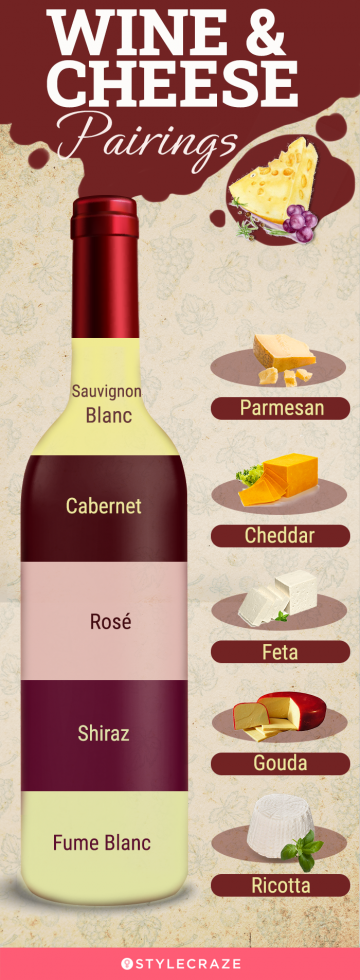
Cheese is a delicious creamy dairy product featured across many cuisines and dishes. The benefits of cheese can be attributed to its minerals, vitamins, fats, and other nutrients. It may help lower blood pressure, improve bone health, and boost weight gain. It may also help improve immunity and dental and thyroid health. It is good for your cognitive function as well. However, excess intake may cause one to develop allergies or lactose intolerance. Moderate intake is recommended.
Frequently Asked Questions
Does cheese increase belly fat?
Cheese is a good source of fat and may increase belly fat.
What happens if I eat cheese everyday?
Daily intake of cheese may offer the benefits mentioned in the article. However, excess consumption may increase the risk of high cholesterol and disrupt heart health.
Can cheese clog your arteries?
Cheese does contain artery-clogging saturated fat, and, therefore, excess intake of cheese can contribute to clogged arteries. Hence, limit cheese consumption in your diet.
Should I stop eating cheese to lose weight?
Cheese may promote weight gain because of its high-calorie content. Limiting or avoiding cheese intake may help you lose weight.
Which cheese is best for weight loss?
Cottage cheese has the lowest fat content and works best for weight loss.
Is cheese good for hair?
Yes. Swiss cheese is rich in vitamin B which may help boost hair growth and improve overall hair health (35), (36).
Is cheese good for stress?
Yes, cheddar cheese contains the amino acid tryptophan which may help reduce the symptoms of anxiety and depression (37).
Key Takeaways
- Cheese contains calcium which helps in strengthening bones and improves dental health.
- It is rich in probiotics, which help promote gut health and boosts immunity.
- You can opt for aged cheese for a firm and sharp flavor.
- Cheese should be avoided by those with lactose intolerance and taking medicines for depression.
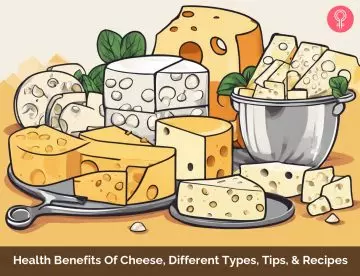
Image: Stable Diffusion/StyleCraze Design Team
Discover the truth about cheese’s impact on your health. Check this informative video for pros and cons and valuable insights to help you make informed decisions about cheese consumption.
Personal Experience: Source
StyleCraze's articles are interwoven with authentic personal narratives that provide depth and resonance to our content. Below are the sources of the personal accounts referenced in this article.
i. I Live For Cheese and Forced Myself to Overcome Lactose Intolerancehttps://annaesq.medium.com/i-live-for-cheese-and-forced-myself-to-overcome-lactose-intolerance-d73e14029c5c
ii. My Love Affair With Cheese
https://medium.com/one-table-one-world/my-love-affair-with-cheese-3e6f90b43842
References
Articles on StyleCraze are backed by verified information from peer-reviewed and academic research papers, reputed organizations, research institutions, and medical associations to ensure accuracy and relevance. Read our editorial policy to learn more.
- “FoodData Central Search Results.” FoodData Central.
https://fdc.nal.usda.gov/fdc-app.html#/food-details/336773/nutrients - Pampaloni, Barbara et al. “Parmigiano Reggiano cheese and bone health.” Clinical cases in mineral and bone metabolism : the official journal of the Italian Society of Osteoporosis, Mineral Metabolism, and Skeletal Diseases vol. 8,3 (2011): 33-6.
https://www.ncbi.nlm.nih.gov/pmc/articles/PMC3279064/ - Iuliano, Sandra, and Tom R Hill. “Dairy foods and bone health throughout the lifespan: a critical appraisal of the evidence.” The British journal of nutrition vol. 121,7 (2019): 763-772.
https://www.ncbi.nlm.nih.gov/pmc/articles/PMC6521786/ - Nordin BE. Calcium and osteoporosis. Nutrition. 1997;13(7-8):664–686.
https://pubmed.ncbi.nlm.nih.gov/9263260/ - “Office of Dietary Supplements – Calcium.” NIH Office of Dietary Supplements, U.S. Department of Health and Human Services,
https://ods.od.nih.gov/factsheets/Calcium-HealthProfessional/. - Dai, Zhaoli, and Woon-Puay Koh. “B-vitamins and bone health–a review of the current evidence.” Nutrients vol. 7,5 3322-46. 7 May. 2015,
https://www.ncbi.nlm.nih.gov/pmc/articles/PMC4446754/ - Herod EL. The effect of cheese on dental caries: a review of the literature. Aust Dent J. 1991;36(2):120–125.
https://pubmed.ncbi.nlm.nih.gov/1877906/ - Tayab, Tabassum et al. “Effect of chewing paneer and cheese on salivary acidogenicity: a comparative study.” International journal of clinical pediatric dentistry vol. 5,1 (2012): 20-4.
https://www.ncbi.nlm.nih.gov/pmc/articles/PMC4093638/ - Aburto, Nancy J et al. “Effect of lower sodium intake on health: systematic review and meta-analyses.” BMJ (Clinical research ed.)vol. 346 f1326. 3 Apr. 2013,
https://www.ncbi.nlm.nih.gov/pmc/articles/PMC4816261/ - Horigan G, McNulty H, Ward M, Strain JJ, Purvis J, Scott JM. Riboflavin lowers blood pressure in cardiovascular disease patients homozygous for the 677C–>T polymorphism in MTHFR. J Hypertens. 2010;28(3):478–486.
https://pubmed.ncbi.nlm.nih.gov/19952781/ - Górska-Warsewicz, Hanna et al. “Milk and Dairy Products and Their Nutritional Contribution to the Average Polish Diet.” Nutrients vol. 11,8 1771. 1 Aug. 2019,
https://www.ncbi.nlm.nih.gov/pmc/articles/PMC6723869/ - Maki, Kevin C et al. “Effects of low-fat dairy intake on blood pressure, endothelial function, and lipoprotein lipids in subjects with prehypertension or stage 1 hypertension.” Vascular health and risk management vol. 9 (2013): 369-79.
- https://www.ncbi.nlm.nih.gov/pmc/articles/PMC3726585/
- Stonehouse, Welma et al. “Dairy Intake Enhances Body Weight and Composition Changes during Energy Restriction in 18-50-Year-Old Adults-A Meta-Analysis of Randomized Controlled Trials.” Nutrients vol. 8,7 394. 1 Jul. 2016.
https://www.ncbi.nlm.nih.gov/pmc/articles/PMC4963870/ - Kim JH, Kim Y, Kim YJ, Park Y. Conjugated Linoleic Acid: Potential Health Benefits as a Functional Food Ingredient. Annu Rev Food Sci Technol. 2016;7:221–244.
https://pubmed.ncbi.nlm.nih.gov/26735796/ - Lordan R, Tsoupras A, Mitra B, Zabetakis I. Dairy Fats and Cardiovascular Disease: Do We Really Need to be Concerned?. Foods. 2018;7(3):29. Published 2018 Mar 1.
https://pubmed.ncbi.nlm.nih.gov/29494487 - Hauswirth CB, Scheeder MR, Beer JH. High omega-3 fatty acid content in alpine cheese: the basis for an alpine paradox. Circulation. 2004;109(1):103–107.
https://pubmed.ncbi.nlm.nih.gov/14676141/ - Walther, Barbara & Schmid, Alexandra & Sieber, Robert & Wehrmuller, Karin. (2008). Cheese in nutrition and health. Dairy Science and Technology. 88. 10.1051/dst:2008012.
https://www.researchgate.net/publication/45450821_Cheese_in_nutrition_and_health - Berra B, Colombo I, Sottocornola E, Giacosa A. Dietary sphingolipids in colorectal cancer prevention. Eur J Cancer Prev. 2002;11(2):193–197.
https://pubmed.ncbi.nlm.nih.gov/11984139/ - Pence BC. Role of calcium in colon cancer prevention: experimental and clinical studies. Mutat Res. 1993;290(1):87–95.
https://pubmed.ncbi.nlm.nih.gov/7694103/ - Kumar, Ashok, and Simar Kaur. “Calcium: A Nutrient in Pregnancy.” Journal of obstetrics and gynaecology of India vol. 67,5 (2017): 313-318.
https://www.ncbi.nlm.nih.gov/pmc/articles/PMC5561751/ - Hosoya T, Ogawa A, Sakai F, Kadooka Y. A cheese-containing diet modulates immune responses and alleviates dextran sodium sulfate-induced colitis in mice. J Dairy Sci. 2012;95(6):2810–2818.
https://pubmed.ncbi.nlm.nih.gov/22612918/ - Shi, Lye Huey et al. “Beneficial Properties of Probiotics.” Tropical life sciences research vol. 27,2 (2016): 73-90.
https://www.ncbi.nlm.nih.gov/pmc/articles/PMC5031164/ - Ibrahim, Fandi, et al. “Probiotics and immunosenescence: cheese as a carrier.”FEMS Immunology & Medical Microbiology 59.1 (2010): 53-59.
https://www.researchgate.net/publication/42254385_Probiotics_and_immunosenescence_Cheese_as_a_carrier - Ventura, Mara et al. “Selenium and Thyroid Disease: From Pathophysiology to Treatment.” International journal of endocrinology vol. 2017 (2017): 1297658.
https://www.ncbi.nlm.nih.gov/pmc/articles/PMC5307254/ - Ano, Yasuhisa, and Hiroyuki Nakayama. “Preventive Effects of Dairy Products on Dementia and the Underlying Mechanisms.” International journal of molecular sciences vol. 19,7 1927. 30 Jun. 2018.
https://www.ncbi.nlm.nih.gov/pmc/articles/PMC6073537/ - Juhl, Christian R et al. “Dairy Intake and Acne Vulgaris: A Systematic Review and Meta-Analysis of 78,529 Children, Adolescents, and Young Adults.” Nutrients vol. 10,8 1049. 9 Aug. 2018.
https://www.ncbi.nlm.nih.gov/pmc/articles/PMC6115795/ - Silanikove, Nissim et al. “The Interrelationships between Lactose Intolerance and the Modern Dairy Industry: Global Perspectives in Evolutional and Historical Backgrounds.” Nutrients vol. 7,9 7312-31. 31 Aug. 2015.
https://www.ncbi.nlm.nih.gov/pmc/articles/PMC4586535/ - Waserman, Susan, and Wade Watson. “Food allergy.” Allergy, asthma, and clinical immunology : official journal of the Canadian Society of Allergy and Clinical Immunology vol. 7 Suppl 1,Suppl 1 S7. 10 Nov. 2011,
https://www.ncbi.nlm.nih.gov/pmc/articles/PMC3245440/ - Sathyanarayana Rao, T S, and Vikram K Yeragani. “Hypertensive crisis and cheese.” Indian journal of psychiatry vol. 51,1 (2009): 65-6.
https://www.ncbi.nlm.nih.gov/pmc/articles/PMC2738414/ - Grillo A, Salvi L, Coruzzi P, Salvi P, Parati G. Sodium Intake and Hypertension. Nutrients. 2019;11(9):1970. Published 2019 Aug 21.
https://pubmed.ncbi.nlm.nih.gov/31438636 - Morrison AC, Ness RB. Sodium intake and cardiovascular disease. Annu Rev Public Health. 2011;32:71–90.
https://pubmed.ncbi.nlm.nih.gov/21219163/ - Williams, Christina D et al. “Dietary calcium and risk for prostate cancer: a case-control study among US veterans.” Preventing chronic disease vol. 9 (2012): E39.
https://www.ncbi.nlm.nih.gov/pmc/articles/PMC3310142/ - “FoodData Central Search Results.” FoodData Central.
https://fdc.nal.usda.gov/fdc-app.html#/food-details/453604/nutrients - Almohana
et al. “The Role of Vitamins and Minerals in Hair Loss: A Review” US National Library of Medicine (2018): 9(1): 51–70. - L-Tryptophan: Basic Metabolic Functions
Behavioral Research and Therapeutic Indications US National Library of Medicine





